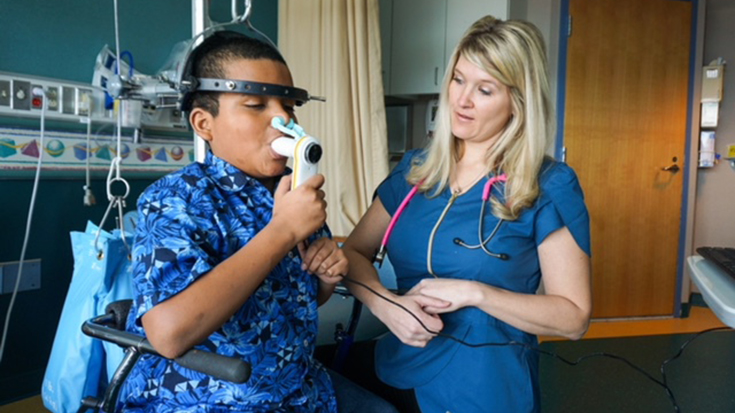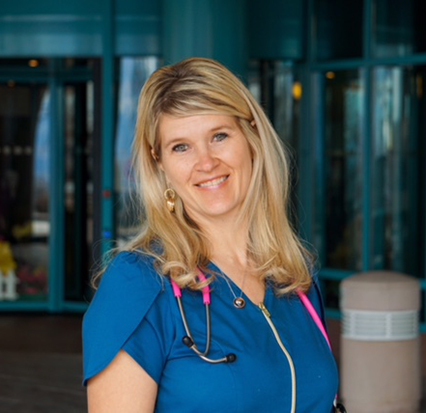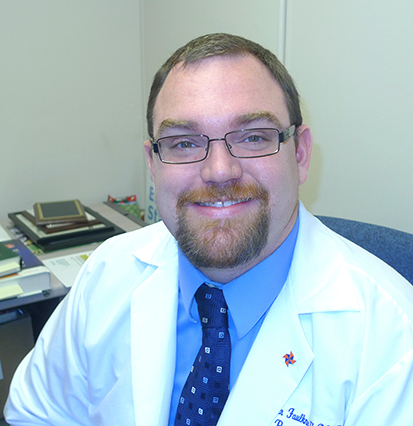
AARC Members Amber Galer, BS, RRT, and Garner Faulkner II, BSRC, RRT, AE-C, share stories of how they deliver compassionate care to those with special needs.
Salt Lake City, UT . . .
A little boy came in for a sleep study aimed at assessing him for sleep apnea in preparation for an upcoming spinal surgery. He had a complex medical history, with hearing loss, blindness, and nonverbal communication.
Light did not change his sleep rhythms, so the only way he knew it was time to sleep is through music vibrations. He had no idea what a sleep study was all about or what the clinicians would be doing to him.
“I was his bedside respiratory therapist and gave him a stuffed dinosaur dressed up to do a sleep study as well,” said Amber Galer, BS, RRT. “He was able to run his fingers over the wires on the dinosaur and was able to identify the wires I was placing on him.”
The sleep study was completed and his physicians got the information they needed to inform his surgery.
Fast forward a few months.
Galer was now working as an RT at Shriners Hospital for Children. She remembered the child when he came in for the surgery. She immediately recognized his need for music to sleep and she knew just how to address his post-surgical needs too.
“While in recovery I dressed up a stuffed bear and used a cannula and mask on the bear so he could identify the supplies and procedures that he required,” says the AARC member.
Early that morning his vitals started to trend lower, oxygen saturation dropped, and he required emergency care with arterial draws and deep suctioning.
“All of the fast-paced and invasive tasks would have made him very scared,” Galer said. But because of the connection they had already made, she was able to keep him calm and he followed all of the medical commands that were given to him.
“His family was at the bedside through it all and were comforted and confident in the care I was giving for a safe and positive outcome,” Galer said.
San Diego, CA . . .
A young woman with cerebral palsy needed an arterial blood gas. She had extremely stiffened arm muscles, which were contracted upward, was wheelchair bound, and nonverbal.
Staff in the PFT lab at UC San Diego knew it would be a difficult stick. Garner Faulkner II, BSRC, RRT, AE-C, saw the anxious look on the faces of her parents.
“They said that usually, it took four or five people to get her blood,” Faulkner said.
He looked at them and smiled.
“No pressure, huh?” he said.
He could see their anxiety visibly lessen with just this small bit of humor.
They told him how much it hurt them to see her in so much pain. He reassured them he would be as quick as possible and then explained that his lab used lidocaine to help minimize the pain. They were grateful.
The procedure began.
“I talked with their daughter the whole time, even commenting on her cute shoes she was wearing,” Faulkner said. “With the assistance of my co-worker holding her arm in place, we were able to get the blood sample pretty quickly and without much anxiety from everyone.”
When it was all over, the woman’s mother pulled Faulkner aside and gave him a hug.
“With a tear in her eye, she thanked me for being so kind and said, ‘I especially want to thank you for talking to my daughter directly . . . you are the first person in a while to treat her like a normal girl,’” Faulkner said.
Child’s play
These two stories speak volumes about caring for special needs patients, and both Galer and Faulkner stress the need for creative thinking when working with them.

For Galer, that means using toys and games geared to each patient’s cognitive and physical level to achieve the respiratory tasks and goals.
“I communicate using hand motions and charts with large pictures in a child-friendly environment that focuses on being calm and helping the patient feel safe with soft blankets and low lighting,” she says.
Her outpatient spirometry clinic has a computer game that opens up a curtain to reveal hidden surprises when kids exhale fast and hard, and she also uses bubbles, party noisemakers and horns, pinwheels, and a special toy that requires a significant breath to levitate a ball above a basket to encourage children to perform their test.
Children get to take the special toy home when the test is complete.
Accommodating their needs

Faulkner says his PFT lab accommodates special needs patients by using a helium dilution technique to measure lung volumes rather than body plethysmography.
They also used a full-size gurney that goes fairly low to the ground for supine spirometry, allowing them to pull wheelchairs right up beside it, where they can assist patients over in the bed with limited need to lift.
“Also, most power chairs will lay back flat, so that supine testing can be done without moving them,” he said.
With patients who have limited control of their bulbar muscles, they often need to use a different mouthpiece seal, or in rare cases, a facemask, to perform testing.
“Another common thing we need in the PFT lab is an accurate height,” Faulkner said. “If patients cannot stand on the scale we will use an arm span measurement to calculate the patient’s height.”
Good advice
Understanding where these patients are coming from is important too.
“I think the biggest advice I can give is to be aware many of these patients are extremely aware of their limitations secondary to their special needs. So there is no need for you to worry about that too,” Faulkner said.
When a patient comes into Faulkner’s lab and sees the body box, often the first thing he’ll say is, Just so you know, I am not going to be able to get in there.
Faulkner reassures the patient that he’ll do whatever it takes to accommodate his needs and that if the patient will give his best effort, they will be able to get thorough results.
“I have found the more they know we are adaptable and that I am not worried about it and can make adjustments as needed to get a good test, the more at ease they will be,” Faulkner said.
Galer says working with special needs children can be challenging, but it is “worth its weight in gold.” The key is to be patient with them and find at least one way to make a connection with them or their family.
“Communication with family is very helpful,” Galer said. “If asked, they will assist greatly and appreciate being involved in their child’s care.”
She says a smile and hug can go a long way too, and so can special treats for the kids.
“If allowed, food, a treat, or even a sticker can make any child giggle,” Galer said.
She gives all her patients and families a thank you note as well, telling them how grateful she feels for being allowed to care for their child and be a part of the recovery or clinic visit.
Remember this
The important thing to remember, say these RTs, is that people with special needs are real people with real lives, just like anybody else.
“Many still have jobs, they have families, they have hobbies, and things they enjoy doing — their disease is something they have, something they have adapted to, but it’s not what defines them,” Faulkner said.
Keep the Conversation Going
What experiences stand out to you from working with patients with unique needs? Share your stories and tips on AARConnect.